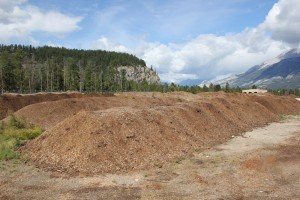
Space for Jasper’s biosolids is running out after tests revealed the compost it produces is unfit for the park.
According to the municipality, space at the Jasper Transfer Station, where Jasper’s biosolids are composted, has become a “critical issue” with stockpiles getting larger and larger.
For the uninitiated, biosolids is organic material removed from Jasper’s wastewater after it is treated. The biosolids are mixed with wood chips at the town’s wastewater treatment plant before being loaded into a dump truck and sent to the transfer station to dry out and cure.
According to the municipality, the mature compost was supposed to be used by Parks Canada as soil for site reclamation, however it has not been used in the park after tests revealed the presence of “viable non-native weed seeds.”
“It’s been a growing problem for several years,” said Janet Coooper, the environmental stewardship coordinator, during a council meeting Aug. 16.
“Everywhere across the province there is a problem with finding the end use for biosolids, it’s not just our problem.”
According to Parks Canada, non-native seeds were found in the compost during testing, rendering it unusable out of fear it could introduce invasive species to the park.
“The term non-native usually refers to plants from other countries, regions, or continents,” wrote Steve Young, a communications officer for Jasper National Park.
“Seeds can be dispersed by wind, water, birds and other animals. They can be found in waste or spoil material and even tiny spores are spread by wind or water, or as a contaminant on clothing, mulch, or landscape material.”
According to the municipality, Jasper’s wastewater treatment plant generates approximately 36,000 metric tonnes of biosolids a year.
The biosolid mixture is laid out in long rows on an asphalt pad at the transfer station and turned over several times over the course of a year and a half to dry out and cure before it is tested and used as “grade B” compost.
But because Parks Canada is not using it, the stockpiles have been getting larger and larger every year forcing the municipality to find a solution.
To rectify the issue, Cooper asked council to approve spending $15,000 from the environmental stewardship reserve fund to pay for a biosolids management plan.
According to Cooper, the plan will evaluate the town’s entire biosolids operation and come up with short-term solutions as well as a long term strategy to manage the growing problem.
Mayor Richard Ireland questioned why Suez North America (formerly United Water), which operates Jasper’s wasterwater treatment plant, is not responsible for resolving the issue.
“My recollection is that we had a design, build, operate contract and when this plant was designed there was an expectation biosolids would be produced and they would be useable,” said Ireland.
“What, if anything, has the contactor done, knowing that there is a building mound of biosolids that is a product of the operation for which they are responsible? Have they contributed any solution to this at all?”
According to Cooper the issue wasn’t brought up until very recently and to date the company has done nothing to resolve the issue.
Council is expected to make a decision on Sept. 6 after Parks Canada reviews the proposal.
Paul Clarke
[email protected]
